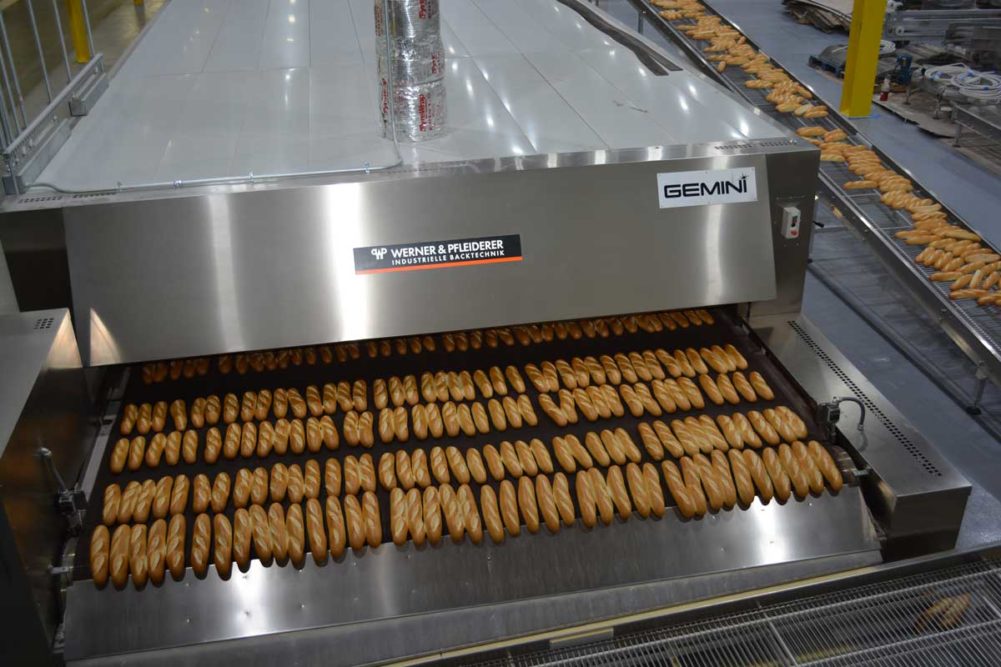Moisture retention and the rate of its removal create crust characteristics ranging from light and crispy to thick and heavy.
“Steaming with a wet, high-quality steam is critical for a good product shine,” Ken Johnson, president, Gemini Bakery Equipment. “Controlling oven moisture is important to prevent underbaked product middles or overbaked dry product crusts.”
Steam quality, he added, can be negatively impacted due to several variables such as distance from the boiler to the oven, pipe size and required steam pressure.
Mr. Johnson said a steam wetting tank located at the oven provides the highest steam quality. “The tank half-fills with condensate and steam from the boiler — bubbles up through the condensate — and is supplied to the oven,” he explained. “This ensures consistently wet, high-quality steam is injected into the oven regardless of the steam condition entering the wetting tank.”
Jerry Barnes, vice president, Babbco, pointed out that these types of tanks should provide dry, saturated steam at 2 to 5 psig for proper deployment. Mass flow meters and proportional valves, along with recipe PLC controls, can monitor the proper amount that’s applied to the products.
“Adjustments can be made on the fly to account for dynamic conditions,” Mr. Barnes said. “The reaction times can be very quick.”
From a more technical perspective, Remco Bijkerk, executive product manager, AMF Den Boer, AMF Bakery Systems, recommended providing steam between 4.3-7.0 psi at 217-223°F, with a minimum volume of 0.5 lbs of steam per square foot of baking area for buns and morning goods and 0.9 lbs of steam per square foot of baking area for tin bread.
“This is relatively low-temperature steam and will condensate at an earlier stage,” Mr. Bijkerk explained.
Patricia Kennedy, president, WP Bakery Group USA, said it’s critical to have an interactive balance between temperature, steam, resting time and air circulation within the oven.
Using a water meter is preferred by many bakers because it controls the amount of steam in the baking chamber. For artisan bread, she suggested adding steam prior to the oven load.
Afterward, the baker can select from three modes. The first requires steaming at the start of the baking process.
Another option involves providing 80% at the beginning and 20% at the end of the first baking step. Yet another mode provides a pulsating stream of steam.
“Pre-steaming is preferred for artisan products, and pulsating steam is very useful for cold and frozen products,” Ms. Kennedy said.
Billy Rinks, national sales account manager, North America, Stewart Systems, a Middleby Bakery company, noted the amount of humidity cannot be controlled by zone in continuous ovens; however, varying the exhaust speed can retain or remove available moisture in the baking chamber.
Typically, Dennis Kauffman, executive product director, AMF BakeTech, AMF Bakery Systems, automatic humidity control adjusts the exhaust damper to maintain the same moisture throughout a continuous oven. The system tracks product flow and only adjusts when the oven is full.
Baking chamber air, he added, is recirculated to maintain consistent humidity throughout the oven while adjustable speed fans maintain constant humidity in each zone.
For bakers, controlling the amount of moisture is as critical as time and temperature when it comes to producing a wide variety of breads and rolls.
If conditions inside the baking chamber get out of whack, blowing off a little steam will create the proper balance, and that makes everyone in the bakery feel good in the long run.
This article is an excerpt from the June 2020 issue of Baking & Snack.To read the entire feature on ovens, click here.





